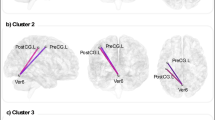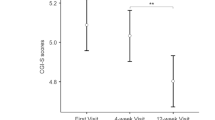Abstract
A hallmark symptom of attention-deficit hyperactivity disorder (ADHD) is an excess of motoric behavior or hyperactivity. Methylphenidate (MPH) is known to reduce hyperactivity in individuals with ADHD. Yet little is known about how it alters neural activity and how this relates to its clinical effects. The goal of this study is to examine MPH-induced changes during resting brain metabolism, and to examine how these changes correlate with measures of behavioral response to the drug. Measures of regional cerebral blood flow (rCBF) using positron emission tomography (PET) were acquired at rest for ten adult subjects with ADHD during both an unmedicated state and after a 3-week period of chronic dosing with a clinically optimal dose of MPH. Compared with the on-MPH condition, the off-MPH condition was associated with relative increases in rCBF bilaterally in the precentral gyri, left caudate nucleus, and right claustrum. The on-MPH condition was associated with relative increases in rCBF in the cerebellar vermis. A correlational analysis measured the relation between rCBF in the off-medication condition to change in ADHD ratings between the off- and on-MPH condition to identify brain regions associated with treatment response. The degree of change in the ratings was negatively correlated with rCBF increases in the midbrain, cerebellar vermis, and the precentral and middle frontal gyri in the off-MPH condition. The majority of these brain regions are involved in the planning and execution of motor behavior. These data suggest that MPH modulates brain regions associated with motor function to achieve a reduction in ADHD symptoms.
Similar content being viewed by others
Log in or create a free account to read this content
Gain free access to this article, as well as selected content from this journal and more on nature.com
or
References
American Psychiatric Association (1994). Diagnostic and Statistical Manual of Mental Disorders. American Psychiatric Association: Washington, DC.
Anderson CM, Polcari A, Lowen SB, Renshaw PF, Teicher MH (2002). Effects of methylphenidate on functional magnetic resonance relaxometry of the cerebellar vermis in boys with ADHD. Am J Psychiatry 159: 1322–1328.
Arnsten AF (2000). Genetics of childhood disorders: XVIII. ADHF, Part 2: norepinephrine has a critical modulatory influence on prefrontal cortical function. 39: 1201–1203.
Barkley RA (1981). Hyperactive Children: A Handbook for Diagnosis and Treatment. Guilford Press: New York.
Berquin PC, Giedd JN, Jacobsen LK, Hamburger SD, Krain AL, Rapoport JL (1998). Cerebellum in attention-deficit hyper-activity disorder: a morphometric MRI study. Neurology 50: 1087–1093.
Biederman J, Spencer T (1999). Attention-deficit/hyperactivity disorder (ADHD) as a noradrenergic disorder. Biol Psychiatry 46: 1234–1242.
Borcherding BG, Keysor CS, Cooper TB, Rapoport JL (1989). Differential effects of methylphenidate and dextroamphetamine on the motor activity level of hyperactive children. Neuropsychopharmacology 2: 255–263.
Bush G, Frazier JA, Rauch SL, Seidman LJ, Whalen PJ, Jenike MA (1999). Anterior cingulate cortex dysfunction in attention-deficit/hyperactivity disorder revealed by fMRI and the counting stroop. Biol Psychiatry 45: 1542–1552.
Castellanos FX, Giedd JN, Berquin PC, Walter JM, Sharp W, Tran T (2001). Quantitative brain magnetic resonance imaging in girls with attention-deficit/hyperactivity disorder. Arch Gen Psychiatry 58: 289–295.
Castellanos F, Giedd J, Marsh W, Hamburger S, Vaituzis A, Dickstein D (1996). Quantitative brain magnetic resonance imaging in attention-deficit hyperactivity disorder. Arch Gen Psychiatry 53: 607–616.
Deragotis LR (1986). Symptom Checklist-90-R: Administration, Scoring, and Procedures Manual, 3rd edn. National Computer Systems, Inc.: Minneapolis.
Ernst M, Zametkin AJ, Matochik JA, Liebenauer L, Fitzgerald GA, Cohen RM (1994). Effects of intravenous dextroamphetamine on brain metabolism in adults with attention-deficit hyperactivity disorder (ADHD). Preliminary findings. Psychopharmacol Bull 30: 219–225.
Ernst M, Zametkin AJ, Matochik JA, Pascualvaca D, Jons PH, Cohen RM (1999). High midbrain [18F]DOPA accumulation in children with attention deficit hyperactivity disorder. Am J Psychiatry 156: 1209–1215.
Ernst M, Zametkin AJ, Matochik J, Schmidt M, Jons PH, Liebenauer LL (1997). Intravenous dextroamphetamine and brain glucose metabolism. Neuropsychopharmacology 17: 391–401.
First M, Gibbon WJ, Spitzer RL (1996). SCID Screen PQ. Multi-Health Systems, North Tonawanda, NY.
Giedd JN, Blumenthal J, Molloy E, Castellanos FX (2001). Brain imaging of attention deficit/hyperactivity disorder. Ann NY Acad Sci 931: 33–49.
Gray JR, Kagan J (2000). The challenge of predicting which children with attention deficit-hyperactivity disorder will respond positively to methylphenidate. J Appl Dev 21: 471–489.
Kuczenski R, Segal DS (2001). Locomotor effects of acute and repeated threshold doses of amphetamine and methylphenidate: relative roles of dopamine and norepinephrine. J Pharmacol Exp Ther 296: 876–883.
Lou H, Henriksen L, Bruhn P (1984). Focal cerebral hypoperfusion in children with dysphasia and/or attention deficit disorder. Arch Neurol 41: 825–829.
Matochik J, Liebenauer L, King C, Szymanski H, Cohen R, Zametkin A (1994). Cerebral glucose metabolism in adults with attention deficit hyperactivity disorder after chronic stimulant treatment. Am J Psychiatry 151: 658–664.
Matochik JA, Nordahl TE, Gross M, Semple WE, King AC, Cohen RM (1993). Effects of acute stimulant medication on cerebral metabolism in adults with hyperactivity. Neuropsychopharmacology 8: 377–386.
Mayberg HS, Brannan SK, Tekell JL, Silva JA, Mahurin RK, McGinnis S (2000). Regional metabolic effects of fluoxetine in major depression: serial changes and relationship to clinical response. Biol Psychiatry 48: 830–843.
Melchitzsky D, Lewis D (2000). Tyrosine hydrolase- and dopamine transporter-immunoractive axons in the primate cerebellum: evidence for a lobular- and laminar-specific dopamine innervation. Neuropsychopharmacology 22: 466–472.
Mostofsky SH, Reiss AL, Lockhart P, Denckla MB (1998). Evaluation of cerebellar size in attention-deficit hyperactivity disorder. J Child Neurol 13: 434–439.
Murphy K, Barkley R (1996). Prevalence of DSM-IV ADHD symptoms in an adult community sample of licensed drivers. J Attention Dis 1: 147–161.
NIMH (1985). Clinical global impression scale. Psychopharmacol Bull 21: 839–844.
Powers RE, O'Connor D, Price D (1989). Noradrenergic systems in human cerebellum. Brain Res 481: 94–199.
Raczkowski D, Kalat J (1974). Reliability and validity of some handedness questionnaire items. Neuropsychologia 12: 43–47.
Rapport MD, DuPaul GJ, Stoner G, Birmingham BK, Masse G (1985). Attention deficit disorder with hyperactivity: differential effects of methylphenidate on impulsivity. Pediatrics 76: 938–943.
Rubia K, Overmeyer S, Taylor E, Brammer M, Williams SC, Simmons A (1999). Hypofrontality in attention deficit hyperactivity disorder during higher-order motor control: a study with functional MRI. Am J Psychiatry 156: 891–896.
Safer DJ, Malever M (2000). Stimulant treatment in Maryland public schools. Pediatrics 106: 533–539.
Salmeron BJ, Stein EA (2002). Pharmacological applications of magnetic resonance imaging. Psychopharmacol Bull 36: 102–129.
Schweitzer JB, Faber TL, Grafton ST, Tune LE, Hoffman JM, Kilts CD (2000). Alterations in the functional anatomy of working memory in adult attention deficit hyperactivity disorder. Am J Psychiatry 157: 278–280.
Solanto MV (1998). Neuropsychopharmacological mechanisms of stimulant drug action in attention-deficit hyperactivity disorder: a review and integration. Behav Brain Res 94: 127–152.
Talairach J, Tournoux P (1988). Co-Planar Stereotaxic Atlas of the Human Brain. Thieme: New York.
Teicher MH, Polcari A, Anderson CM (1996). Dose dependent effects of methylphenidate on activity, attention, and magnetic resonance measures in children with ADHD. Soc Neurosci Abs 22: 1191.
Teicher MH, Anderson CM, Polcari A, Glod CA, Maas LC, Renshaw PF (2000). Functional deficits in basal ganglia of children with attention- deficit/hyperactivity disorder shown with functional magnetic resonance imaging relaxometry. Nat Med 6: 470–473.
Vaidya CJ, Austin G, Kirkorian G, Ridlehuber HW, Desmond JE, Glover GH (1998). Selective effects of methylphenidate in attention deficit hyperactivity disorder: a functional magnetic resonance study. Proc Natl Acad Sci USA 95: 14494–14499.
van der Meere J, Shalev R, Borger N, Gross-Tsur V (1995). Sustained attention, activation and MPH in ADHD: a research note. J Child Psychol Psychiatry 36: 697–703.
Volkow ND, Ding YS, Fowler JS, Wang GJ, Logan J, Gatley JS (1995). Is methylphenidate like cocaine? Studies on their pharmacokinetics and distribution in the human brain. Arch Gen Psychiatry 52: 456–463.
Volkow ND, Wang GJ, Fowler JS, Gatley SJ, Logan J, Ding YS (1998). Dopamine transporter occupancies in the human brain induced by therapeutic doses of oral methylphenidate. Am J Psychiatry 155: 1325–1331.
Volkow ND, Wang GJ, Fowler JS, Logan J, Angrist B, Hitzemann R (1997). Effects of methylphenidate on regional brain glucose metabolism in humans: relationship to dopamine D2 receptors. Am J Psychiatry 154: 50–55.
Volkow ND, Wang G, Fowler JS, Logan J, Gerasimov M, Maynard L (2001). Therapeutic doses of oral methylphenidate significantly increase extracellular dopamine in the human brain. J Neurosci 21: 9414–9418.
Wechsler D (1997). Wechsler Adult Intelligence Scale, 3rd edn. Psychological Corp: New York.
Wellcome Department of Cognitive Neurology (1999). SPM99, Wellcome Department of Cognitive Neurology http://www.fil.ion.ucl.uk/spm.
Wilkinson G (1993). The Wide Range Achievement Test, 3rd edn. Wide Range, Inc.: Wilmington, DE.
Woodworth T (2000). Amphetamine and methylphenidate; DEA congressional testimony. Committee on Education and the Workforce, Subcommittee on Early Childhood, Youth and Families.
Zametkin A, Nordahl T, Gross M, King A, Semple W, Rumsey J (1990). Cerebral glucose metabolism in adults with hyperactivity of childhood onset. N Engl J Med 323: 1361–1366.
Acknowledgements
The study was supported in part by the National Institute of Mental Health (K08 MH01053 & RO3 MH55550) and the William K Warren Foundation. We thank Delecia Votaw, BS, CNMT, Michael White, BS, CNMT, and Margie Jones, BS, CNMT of the Emory Center for PET, the participants and their spouses, friends, and family members for completion of rating scales. We also thank Tim Ely and Caroline Zink for technical assistance and Henry H Holcomb, MD, Deb Medoff, PhD, and Carol Tamminga, MD for their insightful discussions and support.
Author information
Authors and Affiliations
Corresponding author
Rights and permissions
About this article
Cite this article
Schweitzer, J., Lee, D., Hanford, R. et al. A Positron Emission Tomography Study Of Methylphenidate in Adults with ADHD: Alterations in Resting Blood Flow and Predicting Treatment Response. Neuropsychopharmacol 28, 967–973 (2003). https://doi.org/10.1038/sj.npp.1300110
Received:
Revised:
Accepted:
Published:
Issue date:
DOI: https://doi.org/10.1038/sj.npp.1300110
Keywords
This article is cited by
-
Positron emission tomography studies in adult patients with attention-deficit/hyperactivity disorder
Japanese Journal of Radiology (2023)
-
Noradrenergic Pathway to the Cerebellum: the Study Must Go On
The Cerebellum (2022)
-
Long-term effects of stimulant exposure on cerebral blood flow response to methylphenidate and behavior in attention-deficit hyperactivity disorder
Brain Imaging and Behavior (2018)
-
Dopamine D4 Receptor Gene Associated with the Frontal-Striatal-Cerebellar Loop in Children with ADHD: A Resting-State fMRI Study
Neuroscience Bulletin (2018)
-
The effect of single-dose methylphenidate on resting-state network functional connectivity in ADHD
Brain Imaging and Behavior (2017)



